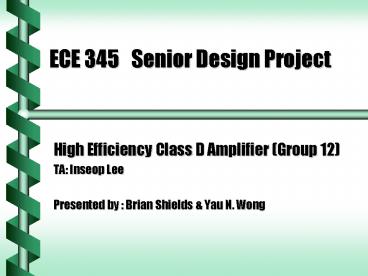ECE 345 Senior Design Project - PowerPoint PPT Presentation
1 / 32
Title:
ECE 345 Senior Design Project
Description:
ECE 345 Senior Design Project High Efficiency Class D Amplifier (Group 12) TA: Inseop Lee Presented by : Brian Shields & Yau N. Wong Delay Circuit To ensure maximum ... – PowerPoint PPT presentation
Number of Views:144
Avg rating:3.0/5.0
Title: ECE 345 Senior Design Project
1
ECE 345 Senior Design Project
- High Efficiency Class D Amplifier (Group 12)
- TA Inseop Lee
- Presented by Brian Shields Yau N. Wong
2
What is Class D Amplifier ?
Block Diagram
- Characteristics
- Driving switching drivers with complementary PWM
signals - Output - no direct path to ground at all time
- Very high power efficiency
3
Why Class D Amplifier ?
- Very High Efficiency Output Stage ( gt 75 )
- High Fidelity can be Achieved ? Low Total
Harmonics Distortion
- Applications
- Hearing Aids
- Most of the portable applications that run on
batteries
4
Overall Design Objective
- Power Efficiency - 75 or Greater
- Fidelity - THD of 1 or Less
5
PWM Generator
6
Audio Preamplifier (LM387)
Block Diagram
- Advantages
- Low Noise ? Improve the overall noise
performance of the amplifier - Internally compensated ? less component counts
7
Triangle Wave Generator
- Requirements
- highly linear ? quality of modulation
- frequency 200KHz or greater
- Several Designs Proposed
- Integration of Square Wave
- Charge and Dump
- LM566 - Voltage Controlled Oscillator
8
Integration of Square Wave
Block Diagram
9
Integration of Square Wave
Simulation Results
- Disadvantage
- Non-stable DC offset and irregular pulse shape
10
Charge and Dump
Block Diagram
11
Charge and Dump
Simulation Results
- Disadvantage
- faster pulse generator needed (555 tried) - 100ns
12
LM566 - Voltage Controlled Oscillator
(Final Design)
- Problem
- 6V DC Bias at output
- Solution
- DC Blocking Capacitor - 0.68uF used
13
Comparator - LM311 !?
Block Diagram
14
Comparator - LM311 !?
Simulation Results
- Simulations worked fine with LM311
- Didnt work on board ? testing ? too SLOW !
15
Comparator - LM360
Block Diagram
- Fast enough ? 20ns max.
- Simple ? No external components required
16
Output Stages
GOALS
- Using the Pulse Width Modulated signal as the
gate input to MOS drivers, deliver power to the
speaker. - Using a simple low pass filter (LPF), remove the
carrier frequency at 200 kHz.
17
Delay Circuit
PURPOSE
- To ensure maximum efficiency, all the power at
the output stage should be delivered across the
speaker. - We need to produce two signals, one for PMOS and
one for NMOS, which ensure both are never on at
the same time.
18
Delay Circuit
SIGNALS NEEDED
19
Delay Circuit
SIGNAL PRODUCTION
20
Delay Circuit
SIGNAL PRODUCTION (cont.)
21
Delay Circuit
OVERALL LOGIC DESIGN
22
Delay Circuit
PSPICE OUTPUT
23
Delay Circuit
DELAY ELEMENT IN CIRCUIT
24
Delay Circuit
PSPICE OUTPUT
25
TTL Signal Amplifier
DS0026
- Purpose
- The TTL output waveforms (3 - 4 volts) are not
guaranteed to turn on MOS devices. - Description
- High speed two-phase clock driver and interface
circuit between TTL logic and MOS logic levels. - Benefits
- 20ns rise/fall times
- High output current drive (1.5 A)
26
MOS Drivers LPF
Logic Design
27
Low Pass Filter
28
Blocking Capacitor
Problem and Solution
- Solution Use two 4700 uF capacitors
- ( 9400 uF) to block signal.
Z .0033 Ohm
29
Efficiency Calculations
Efficiency 0.06125 W / 0.0718 W Efficiency
85.31
30
Testing - Total Harmonic Distortion
(THD)
Block Diagram of Testing Setup
31
Testing - Total Harmonic Distortion
(THD)
- Results
- Highest THD 0.127 at 20KHz
- Lowest THD 0.036 at 2KHz
32
Conclusion
Class D Amplifier
Goals Total Harmonic Distortion lt 1 Efficiency
gt 75
Results Total Harmonic Distortion lt .127
Efficiency 85.31

